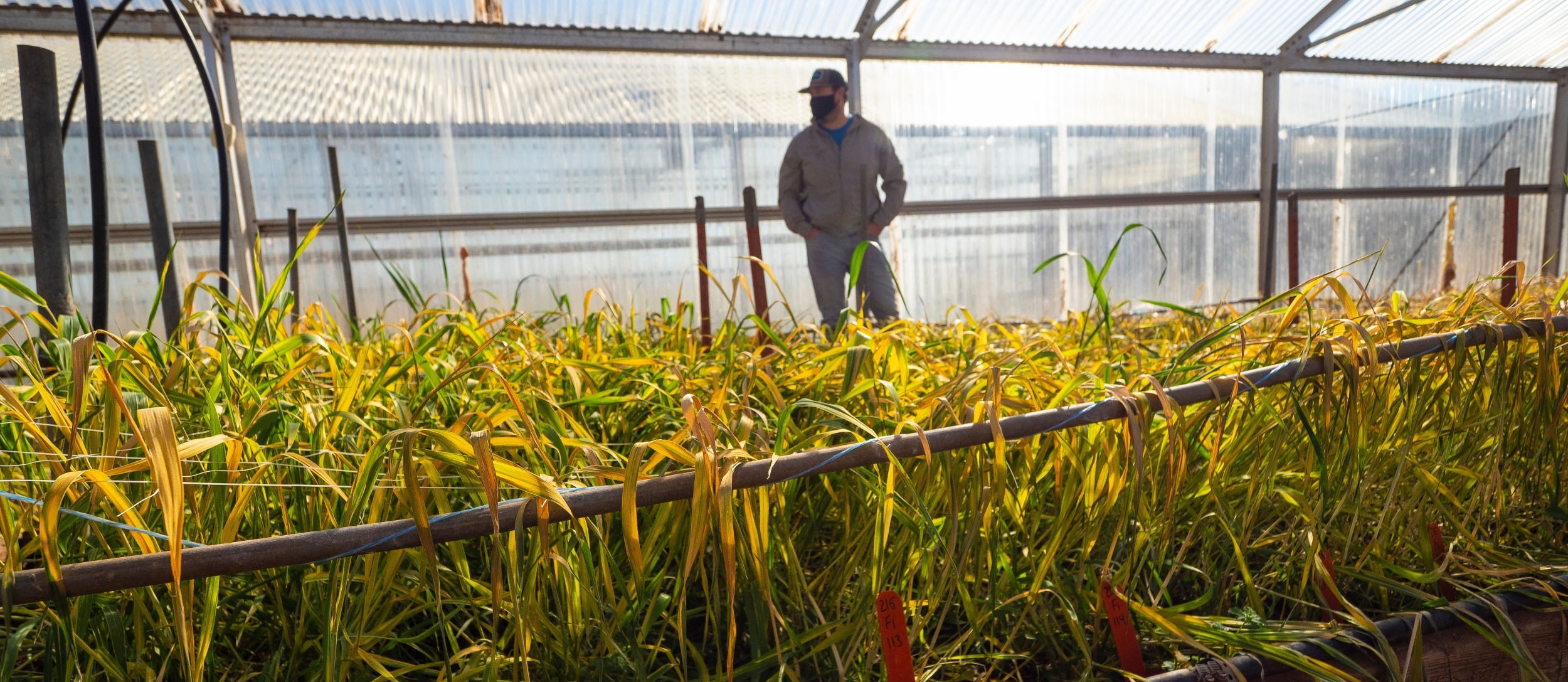
Aging research facilities threaten agricultural innovation
Wednesday, April 14, 2021
Media Contact: Gail Ellis | Communications Specialist, Copywriter | 620-515-2498 | gail.ellis@okstate.edu
When a deep freeze settled across Oklahoma in mid-February, the greenhouse sheltering Oklahoma State University’s wheat breeding program showed its age in the worst way.
Constructed in the 1960s, the facility’s heating system failed, pipes froze, and 70% of the hybrid plants inside succumbed to crippling cold. The loss was catastrophic and exemplified a need to reinvest in the crumbling infrastructure of agricultural research.
“My technicians were working hard to save the plants with space heaters, but the greenhouse still got down in the mid-20s," said Brett Carver, regents professor and OSU wheat genetics chair in agriculture. “If I spend money to buy new heaters, we’re not really making things better. We’re putting band-aids on major wounds here.”
Greenhouses protect genetic wheat stocks that are too risky to be planted in the field, but Carver learned the hard way that OSU doesn’t have the capability anymore to offset harsh outdoor conditions. Hundreds of experimental lines are required to make 1,000 different cross combinations that produce one new wheat variety every year. After February’s devastating freeze, important development has been delayed, and Carver and his team must start over.
“We won’t have enough of this year’s seed to plant in the field next fall. This would have been the up-and-coming material for 10 years down the road,” he said. “We’re just going to have to do it all again.”
Deteriorating greenhouse conditions also limit the wheat team’s growing cycle because once summer temperatures arrive, the facilities lack the cooling capacity to house healthy research.
“If we had new facilities, we could stretch out our season to maybe nine months out of the year and respond quicker to wheat breeding developments that are happening elsewhere in the world,” Carver said.
OSU Wheat Improvement Team colleague Amanda Silva also faces infrastructure challenges with her research. New to the university in 2019, she is building her program and establishing collaborations with national and international partners. If her outdated greenhouse were to struggle to pass standards set by the Animal and Plant Health Inspection Service for plant quarantining, it could impact her research objectives.
“If we received germplasm with disease or insects, we’d have to ensure those things didn’t escape our quarantine room,” she said. “We’ve had to install nets outside of windows, add more protection to vents and place plastic in certain areas to maintain a controlled environment.”
Researchers in OSU Agriculture are making lemonade out of lemons, continuing to accomplish their goals despite the obstacles of old facilities. But Tom Coon, OSU Agriculture vice president and dean, wonders what his star researchers could conquer if new state-of-the-art equipment and spaces better suited their abilities and expertise.
“The greatest culprit of this issue is time,” Coon said. “We have a teaching lab that was built in 1957 when facilities were based on the model of a master scientist. Professors had their own space, but today they use their greatest talents by working alongside other scientists and students.”
For academics, research and OSU Extension, OSU university scientists deserve an upgrade in infrastructure to help Oklahoma producers compete in international markets.
“We’ve got to equip them with the genetics, knowledge and tools to succeed with a superior product,” Coon said.
OSU is not the only state institution hindered by dilapidated research facilities. A 2020 study released by the Association of Public and Land-Grant Universities reports $11.5 billion in repairs and renovations are needed at schools of agriculture authorized to receive U.S. Department of Agriculture research funding nationwide. APLU data indicates 69% of the buildings at 97 land-grant universities are more than 25 years old and require urgent upgrades to remain safe and effective. This statistic includes experimental farms, greenhouses and support facilities — ag innovation centers established through State Ag Experiment Stations, 1890s institutions and Tribal Colleges.
A continued lack of funding to address university research infrastructure will negatively affect the agriculture, food and related industries that annually contribute $1.1 trillion to America’s economy. The future of scientific discovery, economic vitality, food production and health are at stake. APLU findings conclude declining facilities threaten critical research on food safety and security, natural resources, climate change and other key areas of basic societal functions.
“Our nation’s research facilities and infrastructure need to be the best to ensure global superiority and attract the brightest scientific minds from all over the world,” said U.S. Rep. Frank Lucas of Oklahoma’s third congressional district.
As the White House rolls out its proposed infrastructure bill, Lucas is introducing his Securing American Leadership in Science and Technology legislation. The plan would double basic research funding over the next 10 years while investing in key research facilities and the domestic STEM worker pipeline.
“Prioritizing research will keep our land-grant universities like Oklahoma State at the forefront of innovation and benefit the lives of all Americans,” Lucas said. “I’m optimistic Congress can reach a bipartisan agreement on legislation that delivers responsible, targeted investments across the nation.”
